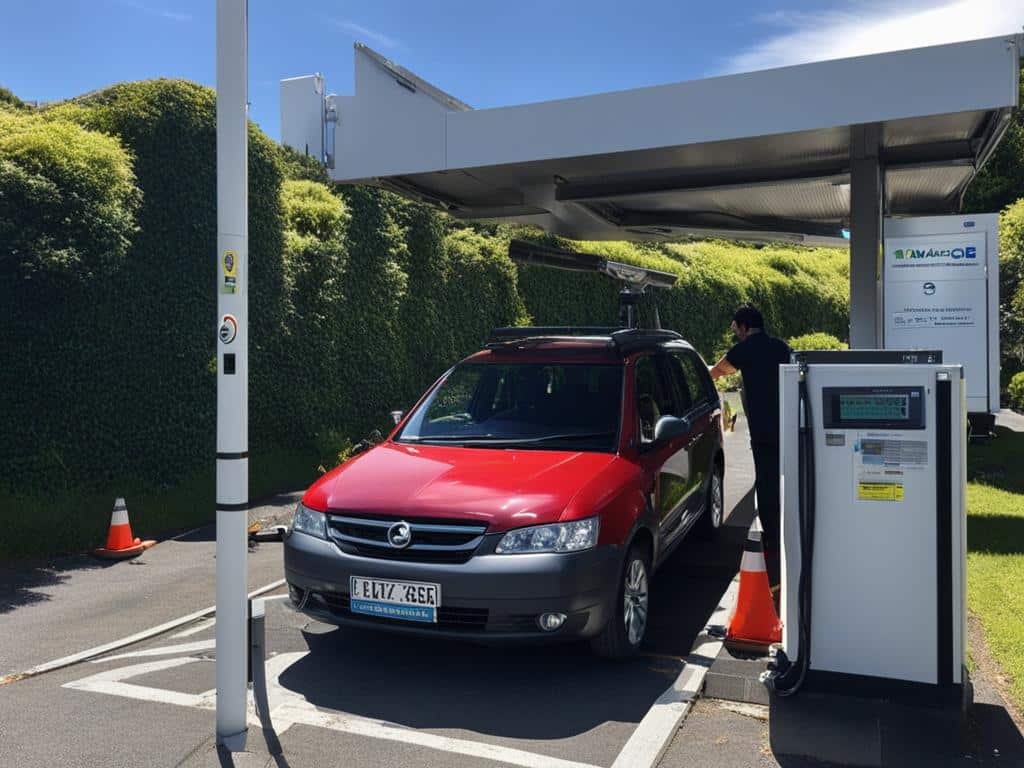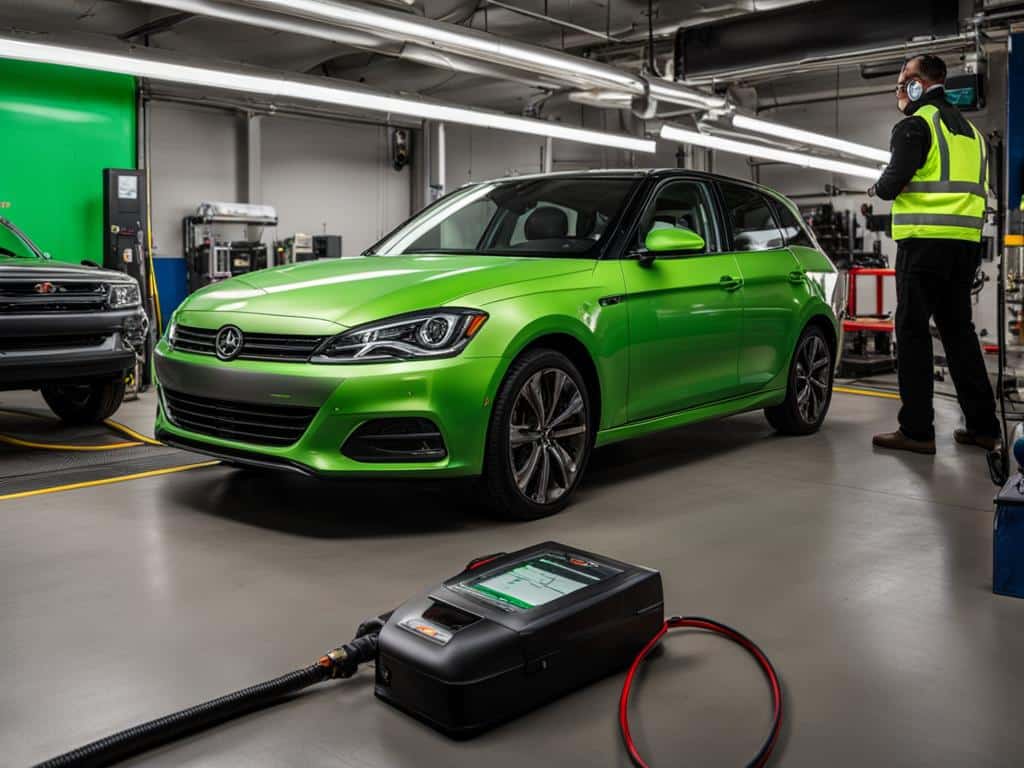In New Zealand, it is essential to regularly check the emissions of your vehicle to ensure compliance with the country’s emission standards. Failure to meet these standards can lead to vehicle rejection during inspections, resulting in potential fines or even the revocation of registration. This guide will provide you with all the information you need to easily check the emissions on your car in NZ and ensure adherence to the country’s regulations.
Key Takeaways:
- Regularly check your vehicle’s emissions to comply with New Zealand’s emission standards.
- Failure to meet emission standards can result in fines or registration revocation.
- Understanding the reasons for rejection during emissions testing is crucial.
- Vehicle emissions in NZ are regulated by the Land Transport Rule: Vehicle Exhaust Emissions 2007.
- Different tests are conducted for petrol, LPG, CNG, and diesel vehicles to measure emissions.
- Entry and in-service certifications ensure vehicles meet emission standards and are safe on NZ roads.
- Contributing to cleaner air and a healthier environment is a responsibility for all vehicle owners.
Reasons for Rejection of Vehicle Emissions in New Zealand
In New Zealand, vehicles undergo emissions testing to ensure compliance with the country’s emission standards. Understanding the reasons for rejection during these tests is crucial to ensure that your vehicle passes inspections and meets the necessary requirements. Here are some key reasons why vehicles may be rejected for emissions in New Zealand:
1. Visible Smoke Emissions
During emissions testing, if a vehicle emits clearly visible smoke from the exhaust tailpipe for a continuous period of five seconds while idling or during rapid acceleration, it can be rejected. This indicates that the vehicle’s emissions are not within the acceptable limits and may be contributing to air pollution.
2. Removal of Catalytic Converter or Diesel Particulate Filter
If a vehicle has had its catalytic converter or diesel particulate filter removed without valid documentation of a passed emissions test, it can also be rejected. These components play a crucial role in reducing harmful emissions, and their removal can result in higher pollution levels.
It is important to note that these reasons for rejection may vary depending on the specific emission testing standards and regulations in different regions of New Zealand. It is advisable to consult the local authorities or emission testing centers for the most accurate and up-to-date information.
Ensuring that your vehicle meets the necessary emission standards is not only a legal requirement but also essential for protecting the environment and public health. Regular emissions testing and proper maintenance of your vehicle’s emissions control system can contribute to cleaner air and a healthier New Zealand.
Legislative Requirements for Vehicle Emissions in NZ
In New Zealand, vehicle emissions are subject to legislative requirements outlined in the Land Transport Rule: Vehicle Exhaust Emissions 2007. These regulations aim to minimize the impact of motor vehicle emissions on air quality and public health. It is essential for vehicle owners to understand and comply with these requirements to ensure a cleaner and healthier environment for all.
Requirements for Exhaust Emissions
The Land Transport Rule specifies that motor vehicles must not emit clearly visible smoke from the exhaust tailpipe when the engine is running at its normal operating temperature. This applies to both idling and rapid acceleration. Visible smoke is an indication of poor combustion and can contribute to air pollution. By adhering to these requirements, vehicle owners can play their part in reducing harmful emissions.
Prohibition of Exhaust System Modification
The legislation also states that the exhaust emissions system or exhaust control equipment of a vehicle must not be modified in a way that hinders the vehicle from passing a prescribed metered emissions test. This means that any modifications to the exhaust system that could potentially increase emissions are prohibited. It is important to ensure that any modifications made to your vehicle comply with these regulations to avoid unnecessary penalties.
| Requirement | Description |
|---|---|
| Smoke Emission | A motor vehicle must not emit clearly visible smoke when the engine is running at its normal operating temperature, both while idling and during rapid acceleration. |
| Exhaust System Modification | The exhaust emissions system or exhaust control equipment of a vehicle must not be modified to hinder the vehicle from passing a prescribed metered emissions test. |
By familiarizing yourself with these legislative requirements and ensuring that your vehicle meets the necessary emission standards, you can contribute to a cleaner and healthier environment in New Zealand. Regular emissions testing and compliance with the law are essential for maintaining the air quality and protecting public health.

Procedures for Measuring Vehicle Emissions in New Zealand
In New Zealand, measuring vehicle emissions is essential for ensuring compliance with the country’s emission standards and maintaining air quality. The procedures for measuring car emissions in New Zealand differ depending on the type of fuel the vehicle uses: petrol, LPG, CNG, or diesel. Let’s explore the specific tests and steps involved in each case.
1. Petrol, LPG, and CNG Vehicles
For vehicles running on petrol, LPG, or CNG, the exhaust emissions test is performed to measure the levels of carbon monoxide (CO) and hydrocarbons (HC). This test is conducted using specialized equipment that analyzes the emissions while the vehicle is running.
The procedure for conducting the exhaust emissions test involves:
- Warming up the equipment to ensure accurate readings
- Ensuring the vehicle is at its normal operating temperature by driving it for a specific distance or time
- Connecting the emissions testing equipment to the vehicle’s exhaust system
- Running the vehicle’s engine at idling and during rapid acceleration while monitoring the emissions levels
Based on the emissions readings, the vehicle will either pass or fail the test according to the specified emission limits.
2. Diesel Vehicles
For diesel vehicles, the opacity test is carried out to measure the level of smoke emitted from the exhaust. This test is conducted using an opacimeter, which measures the opacity or darkness of the exhaust smoke.
The procedure for conducting the opacity test involves:
- Warming up the opacimeter to ensure accurate readings
- Ensuring the vehicle is at its normal operating temperature by driving it for a specific distance or time
- Positioning the opacimeter’s probe near the exhaust pipe
- Accelerating the vehicle while the opacimeter measures the opacity of the exhaust smoke
Based on the opacity reading, the vehicle will either pass or fail the test according to the specified limits.
Measuring vehicle emissions is a crucial part of ensuring that our vehicles are environmentally friendly and comply with New Zealand’s emission standards. By following the prescribed procedures and conducting regular emission tests, we can all contribute to reducing car pollution and improving air quality for a healthier and greener New Zealand.
Entry and In-Service Certification for Vehicle Emissions in New Zealand
In New Zealand, ensuring that vehicles meet the required emissions standards is a crucial part of both the entry certification and in-service certification processes. These certifications are necessary to ensure the safety and compliance of vehicles on New Zealand roads. Let’s take a closer look at each certification and how they contribute to maintaining the country’s emission standards.
Entry Certification
Entry certification is the process that vehicles go through when they are first registered in New Zealand. This certification is carried out by entry certifiers, such as VTNZ, VINZ, and NZAA. During the entry certification process, vehicles undergo a thorough inspection to ensure that they meet the necessary emission standards and safety requirements. This includes checking the vehicle’s emissions levels, among other criteria. Only after successfully passing the entry certification can a vehicle be registered and legally operated in New Zealand.
In-Service Certification
In-service certification includes periodic inspections that vehicles must undergo throughout their life on the road in New Zealand. These inspections include the warrant of fitness (WoF) and certificate of fitness (CoF) inspections. These inspections, which are typically required on an annual basis, aim to ensure that vehicles continue to meet the necessary emission standards and safety requirements. Authorized inspection centers, such as independent garages and testing stations, perform these inspections and issue the necessary certifications once the vehicles pass the tests.
By implementing entry and in-service certification processes, New Zealand is able to maintain its car emission standards and ensure that vehicles on its roads are safe and environmentally friendly.

| Benefits of Entry and In-Service Certification | Why It Matters |
|---|---|
| Ensures compliance with emission standards | Keeps the air clean and protects public health |
| Ensures vehicles meet safety requirements | Reduces the risk of accidents and injuries on the road |
| Identifies maintenance issues early on | Helps prevent breakdowns and improves overall vehicle performance |
Conclusion
Checking emissions on your car in NZ is a crucial step to ensure compliance with the country’s emission standards and contribute to a cleaner environment. Regular car emissions testing is not only a legal requirement but also essential for maintaining air quality and protecting public health.
By following the procedures outlined in this guide, you can easily check the emissions on your car and ensure it meets the necessary standards. This will help you avoid potential fines and the revocation of your vehicle’s registration during inspections.
Remember that vehicle emissions inspections are not only carried out during entry certification but also during periodic inspections like the warrant of fitness (WoF) and certificate of fitness (CoF) inspections. Complying with these inspections and keeping your vehicle’s emissions in check are essential for keeping your vehicle on the road and avoiding penalties.
Take the necessary steps to check emissions on your car today and contribute to a greener future for New Zealand. By doing so, you will play a vital role in maintaining air quality and protecting the well-being of the community.
FAQ
What are the consequences if my vehicle fails an emissions test in New Zealand?
If your vehicle fails an emissions test in New Zealand, it may be rejected during inspections. This can result in potential fines or even the revocation of the vehicle’s registration.
What are the reasons for rejection of vehicle emissions in New Zealand?
A vehicle can be rejected during emissions testing in New Zealand if it emits clearly visible smoke from the exhaust tailpipe for a continuous period of five seconds while idling or during rapid acceleration. Additionally, if a vehicle has had its catalytic converter or diesel particulate filter removed without valid documentation of a passed emissions test, it can also be rejected.
What are the legislative requirements for vehicle emissions in NZ?
Vehicle emissions in New Zealand are regulated by the Land Transport Rule: Vehicle Exhaust Emissions 2007. This rule specifies that a motor vehicle must not emit clearly visible smoke when the engine is running at its normal operating temperature, both while idling and during rapid acceleration. The exhaust emissions system or exhaust control equipment of a vehicle must not be modified to hinder the vehicle from passing a prescribed metered emissions test.
How are vehicle emissions measured in New Zealand?
In New Zealand, vehicle emissions can be measured through different tests depending on the type of fuel the vehicle uses. Petrol, LPG, and CNG vehicles undergo an exhaust emissions test that measures the levels of carbon monoxide and hydrocarbons. Diesel vehicles, on the other hand, are tested using an opacimeter to measure the opacity of the exhaust smoke.
What is the process of entry and in-service certification for vehicle emissions in New Zealand?
In New Zealand, vehicles undergo both entry certification, which occurs when a vehicle is first registered in the country, and in-service certification, which includes periodic inspections such as the warrant of fitness (WoF) and certificate of fitness (CoF) inspections. Entry certification is carried out by entry certifiers, such as VTNZ, VINZ, and NZAA, while in-service inspections are conducted by authorized inspection centers.
Why is it important to check emissions on my car in NZ?
Checking emissions on your car in NZ is not only a legal requirement but also crucial for maintaining air quality and protecting public health. By ensuring that your vehicle meets the necessary emission standards, you can contribute to a cleaner and healthier environment in New Zealand.




